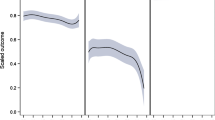Abstract
Objective
To impute limited health literacy from commonly measured socio-demographic data and to compare it to the Short-Test of Functional Health Literacy in Adults (S-TOFHLA) for estimating the influence of limited health literacy on health status in the elderly.
Methods
The Prudential Medicare Study assesses the S-TOFHLA score, leading to a “reference standard” classification of 25% of people with inadequate literacy; the National Health Interview Survey has no such assessment. We estimated a regression of S-TOFHLA on sex, age, years of schooling, and race/ethnicity in The Prudential Medicare Study data to derive a Demographic Assessment for Health Literacy (DAHL) score, and imputed inadequate literacy to the 25% with the lowest DAHL scores. Using regression, we then examined associations between several health status measures (including hypertension, diabetes, physical and mental SF-12) and inadequate literacy (imputed or test-based).
Results
Estimates of association using imputed inadequate literacy closely approximate those obtained using S-TOFHLA-based inadequate literacy for most outcomes examined.
Conclusions
As few population surveys measure health literacy, the DAHL, a readily calculated health literacy proxy score, may be useful for expanding the scope of health literacy research in national survey data.


Similar content being viewed by others
References
Nielsen-Bohlman L, Panzer A, Hamlin B, Kindig D. (National Academies Press). Health literacy: a prescription to end confusion. 2004.
Kutner M, Greenberg E, Jin Y, Paulsen C. (US Department of Education, National Center for Education Statistics). The health literacy of america's adults: results from the 2003 national assessment of adult literacy. 2006.
DeWalt DA, Berkman ND, Sheridan S, Lohr KN, Pignone MP. Literacy and health outcomes. A systematic review of the literature. J Gen Intern Med.. 2004;19(12):1228–1239.
Sudore RL, Yaffe K, Satterfield S, et al. Limited literacy and mortality in the elderly: the health, aging, and body composition study. J Gen Intern Med. 2006;21(8):806–812.
Paasche-Orlow MK, Parker RM, Gazmararian JA, Nielsen-Bohlman LT, Rudd RR. The prevalence of limited health literacy. J Gen Intern Med. 2005;20(2):175–184.
Baker DW, Gazmararian JA, Williams MV, et al. Functional health literacy and the risk of hospital admission among Medicare managed care enrollees. Am J Public Health. 2002;92(8):1278–83.
Davis TC, Long SW, Jackson RH, et al. Rapid estimate of adult literacy in medicine: a shortened screening instrument. Fam Med. 1993;25(6):391–5.
DeWalt DA, Pignone MP. Reading is fundamental: The relationship between literacy and health. Arch Intern Med. 2005;165(17):1943–1944.
Parker RM, Baker DW, Williams MV, Nurss JR. The test of functional health literacy in adults: a new instrument for measuring patients’ literacy skills. J Gen Intern Med. 1995;10(10):537–41.
Gazmararian JA, Baker DW, Williams MV, et al. Health literacy among Medicare enrollees in a managed care organization. JAMA. 1999;281(6):545–551.
Paasche-Orlow M, Hanchate A. Modeling literacy with sociodemographic characteristics and literacy activities. J Gen Intern Med. 2005;21(S4):88.
Miller MJ, Degenholtz HB, Gazmararian JA, Lin CJ, Ricci EM, Sereika SM. Identifying elderly at greatest risk of inadequate health literacy: A predictive model for population-health decision makers. Res Social Adm Pharm. 2007;3(1):70–85.
The American Association for Public Opinion Research. (AAPOR). Standard definitions: final dispositions of case codes and outcome rates for surveys, 4th edition. 2006.
Scott TL, Gazmararian JA, Williams MV, Baker DW. Health literacy and preventive health care use among Medicare enrollees in a managed care organization. Med Care. 2002;40(5):395–404.
Howard DH, Sentell T, Gazmararian JA. Impact of health literacy on socioeconomic and racial differences in health in an elderly population. J Gen Intern Med. 2006;21(8):857–861.
Gazmararian JA, Kripalani S, Miller MJ, Echt KV, Ren J, Rask K. Factors associated with medication refill adherence in cardiovascular-related diseases: a focus on health literacy. J Gen Intern Med. 2006;21(12):1215–1221.
Baker DW, Gazmararian JA, Williams MV, et al. Health literacy and use of outpatient physician services by Medicare managed care enrollees. J Gen Intern Med. 2004;19(3):215–220.
Wolf MS, Gazmararian JA, Baker DW. Health literacy and functional health status among older adults. Arch Intern Med. 2005;165(17):1946–52.
Scott TL, Gazmararian JA, Williams MV, Baker DW. Health literacy and preventive health care use among Medicare enrollees in a managed care organization. Med Care. 2002;40(5):395–404.
Ware J. The MOS 36-item short-form health survey (SF-36). In: Sederer L, Dickey B, eds. Outcomes assessment in clinical practice. Baltimore, MD: Williams & Wilkins; 1996:61–64.
U. S. Department of Health and Human Services. NATIONAL HEALTH INTERVIEW SURVEY, 1997 [Computer file] 2nd ICPSR version. Hyattsville, MD: US Dept. of Health and Human Services, National Center for Health Statistics [producer], 1996. Ann Arbor, MI: Inter-university Consortium for Political and Social Research [distributor]; 2001.
Brindle P, Emberson J, Lampe F, et al. Predictive accuracy of the Framingham coronary risk score in British men: prospective cohort study. BMJ. 2003;327(7426):1267.
Hanley JA, McNeil BJ. The meaning and use of the area under a receiver operating characteristic (ROC) curve. Radiology. 1982;143(1):29–36.
StataCorp. Stata Statistical Software: Release 9 College Stataion, TX: StataCorp LP; 2005.
Acknowledgements
The findings of this study were presented at the 2007 Annual Meetings of both the Society of General Internal Medicine (April 25–28, Toronto) and the AcademyHealth (June 3–5, Orlando, FL).
Potential conflicts of interest
None disclosed.
Author information
Authors and Affiliations
Corresponding author
Rights and permissions
About this article
Cite this article
Hanchate, A.D., Ash, A.S., Gazmararian, J.A. et al. The Demographic Assessment for Health Literacy (DAHL): A New Tool for Estimating Associations between Health Literacy and Outcomes in National Surveys. J GEN INTERN MED 23, 1561–1566 (2008). https://doi.org/10.1007/s11606-008-0699-5
Received:
Revised:
Accepted:
Published:
Issue Date:
DOI: https://doi.org/10.1007/s11606-008-0699-5




